#bronze age jewelry
Explore tagged Tumblr posts
Text


Plant Remains Survived 3,000-Years on Bronze Age Bracelets
Rare remains of plants have been found on Bronze Age jewellery uncovered in the Highlands.
Archaeologists said the fibrous cords used to knot together bracelets had survived for about 3,000 years.
The ancient hoard, which appears to have been carefully buried, was found at a building site in Rosemarkie on the Black Isle where a Bronze Age village once stood.
It contained nine bronze bracelets and necklaces buried sometime around 1000 BC.




Guard Archaeology, working with Scottish Conservation Studio, carried out laboratory investigations of the discoveries.
Rachel Buckley, who led the work, said: "While there are other examples of hoards where it has been postulated that items were bound together due to their positioning, the vegetation in the Rosemarkie hoard has survived for approximately 3,000 years, proving that these artefacts were held together."
Archaeologists said the finds would help to improve knowledge of the lives, beliefs and deaths of Bronze Age people in the Highlands.
They also said it would add to what Guard Archaeologists have gleaned from another Bronze Age hoard they excavated in Carnoustie.
Iraia Arabaolaza, who is managing Guard Archaeology’s analyses, said there was interest around how the hoard was buried.
She said: "It would seem that the shallow pit was dug to the required length and depth to accommodate the items, before then being quickly backfilled.



"It may be that it was intended as temporary storage with the intention of recovering the hoard at some stage.
"The evidence from the surrounding settlement may reveal whether it was not just the hoard that was abandoned but the settlement as well."
The archaeological work was funded by developer Pat Munro (Alness) Ltd.

#Plant Remains Survived 3000-Years on Bronze Age Bracelets#Rosemarkie#Black Isle#bronze#bronze age jewelry#ancient artifacts#archeology#archeolgst#history#history news#ancient history#ancient culture#ancient civilizations#bronze age#ancient art
39 notes
·
View notes
Text

Silver Necklace circa the Bronze Age, c1500 BC
Via The Cleveland Museum of Art, Department of Greek and Roman Art
#jewelry document#jewelry history#jewellery#jewelry research#Silver Necklace#bronze age#ancient cultures
243 notes
·
View notes
Text

Bronze belt uncovered near Le Theil, France, circa 1200 BC
from The National Museum of Archaeology, France
453 notes
·
View notes
Text
Hoard of Bronze Age jewelry discovered in Poland was part of ancient water burial ritual, study finds
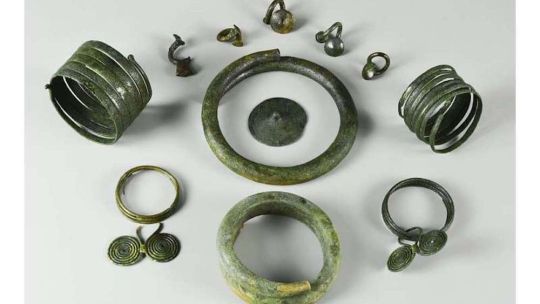
Archaeologists in Poland have discovered a collection of more than 550 pieces of Bronze Age jewelry that were once part of an ancient burial ritual.
Known as Papowo Biskupie, the dried-out lake bed site was occupied from roughly 1200 to 450 B.C. by the Chełmno group, a community from the larger Lusatian culture that lived in northern Europe during the Late Bronze Age and Early Iron Age, according to a study published Wednesday (Jan. 24) in the journal Antiquity.
The Lusatians are best known for their ritual depositions of metal hoards in bodies of water. However, the Chełmno group was not known for engaging in this practice.
But the new jewelry finding, made by metal detectorists in 2023, upends that perception. Read more.
344 notes
·
View notes
Note
Hey there, since you're an archeologist I tought you were the best person I could ask! Do you know something about minoic/mycenean/doric clothes? Like the different kinds that exist and what they're used for or by whom, what kind of fabric are used, what colors, etc,,,
I wanted to design some mythical characters, but I cannot find a reliable source or something detailed about them, so even if you could link me to some page, it would great! (Even if you don't it's no problem, I'm just trying haha)
Thanks ^^
Oh that is a very interesting question and rather wide so I will try to keep it compressed enough so it will not be boring or tiring! Of course the periods are connected to each other and at some point we sure are to expect the styles to co-intricate with each other (for example at several occasions Mycenaeans have very similar iconography as the Minoans -see for example ceremonial images - but as years pass they develop their own style and we see more commonly images with women and men have covered torsos as opposing to the almost always bare chests of minoan men and women.
Now "doric clothes" is a very wide category. As I said Doric Greek tribes descended from the north at around 1100 BC and they stayed ever since in history. Places like north Greece like Macedonia did speak in a Doric Greek dialect. So did the Spartans in the south who are some of the most famous examples of Doric Greek so their clothing depends on the era we talk about.
Of course when it comes to the Minoans (c.a. 3100 BC-1450 BC) we know little on society and such but we have a very rich set of depictions and decorations or statuettes that depict clothing. Men and women in frescoes are generally depicted in a similar manner with the Egyptian counterparts where women are pointed out with white pigment and men with red pigment (distinction that seems very useful in the infamous bull-leaping images where both men and women are dressed in a similar manner so the color differences are needed to point out the two genders (of course there are some professors who debate that fact but this theory is the most prominient one so far), for example I have seen also the suggestion that tan was preferred for men but not for women but I wouldn't be massively convinced on that idea as much but that is up to you.
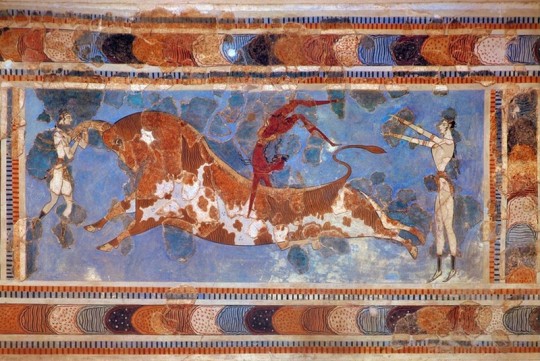
In sports images like this we see both men and women dressed in this loin-cloth material that leaves the torso bare so they will not get caught to the horns of the bull.
Of course one of the most famous ones is the so-called "Snake Goddess" which depicts a very common set of clothing:

This is what we might call a typical set of clothing for the minoan period from what we know. A classical set is the full skirt with the intricate colorings and patterns, a corset-like garment that puts emphasis on the waist and supports the bodice and a typical short-sleeved top that leaves the breasts open. Although I believe realistically speaking we should expect simpler dresses for the lower clsses of women or that we can assume these types are more official or ceremonial it does seem like the Minoan civilization has less rules for modesty XD. Women had their hair long and arranged in braids or locks (there are even people who estimate that the minoans have some of the earliest depictions of locked hair in history) More often whatnot they arranged their hair with jewelry and from the frescoes we know they had very vibrant colors.

Judging from the coloring patterns and such I would say that woolen materials were used although looming comes in popularity in later years.
Women also wore a variety of accessories in their hair and bodies with beaded necklacess and golden earrings

We have actually some really beautiful examples of golden jewelry from that time

Or the famous "bees" pendant
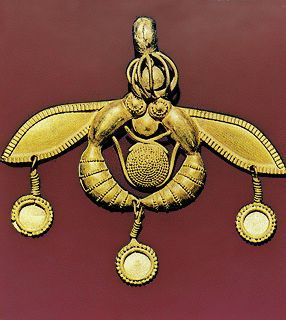
We can also safely assume that women wore makeup from the fresco discovered in Knossos that was named "Parisian girl" because of her red lipstick and jewelry

Now men also have very vibrant colors but by n large they are depicted bare-chested wearing usally skirts or loincloths around their waists as they perform their activities
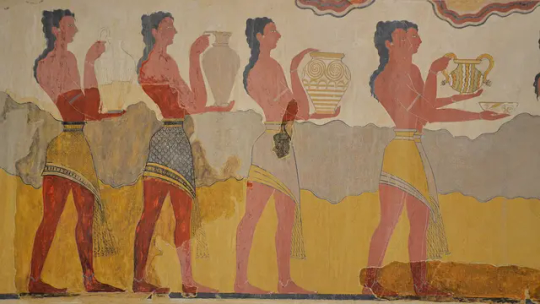
We see intricate geometric patterns in some of their clothes and we see they keep their hair also long and carefully arranged. We also see them most of the time clean-shaven and we do discover blades that we estimate they were used as razors so it seems that shaving played a big part in their culture. For men we do not see so vibrant depictions of jewelry but we do discover impressive sigil rings in their tomb. And of course there is the infamous "Prince with the Lillies"

Of course this representation was initially suggested by Arthur Evans and there is little to no guarantee that this is how it really looked like (the hat in particular has been commented by recent professors I interracted with, with a female type of hat) but it still remains a famous depiction to this day. The loin cloth that he is wearing resembles the bull fighters
Now do I believe it is possible they had warmer clothing for winter? Absolutely even if we do not see as cold climates in southern Greece especially at those times I believe one could assume some warmer garment to be worn but unfortunately is hard to tell from iconography only.
The Mycenaeans (c.a. 1700s BC-1100 BC) as I said before do have a very similar iconography to the Minoan times but later on they establish their own style. We do have processions such as the one discovered in the palace of Pylos in whic the procession of women is dressed up in an identical fashion with the minoan counterparts:

There seems to be the suggestion though that this kind of garments were mostly used by the elite class and/or for ceremonial purposes instead of everyday life. Which seems to be supported by the fact that we usually see heavily decorated women walk in processions. Instead we see more and more women covering their chests with bodices or with the dress itself such as below:

And this is a possible reconstruction:

We also see a variety of hairstyles like the one above with ladies wear their hair either in long locks or brushed like we saw before or gathered up in smaller buns and arrangements like the lady above. Other clothing such as this suggestion from Mycenae show even intriquette shawls or robes such as these:

Other chitons that have longer sleeves seem to be painted upon mycenaean statuettes as well.
With accessories we see also jewelry of gold or beads and on makeup we see examples of these rosettes or circular patterns on faces of women. I really like this project that seems to try and reconstruct Helen based on Mycenaean images:
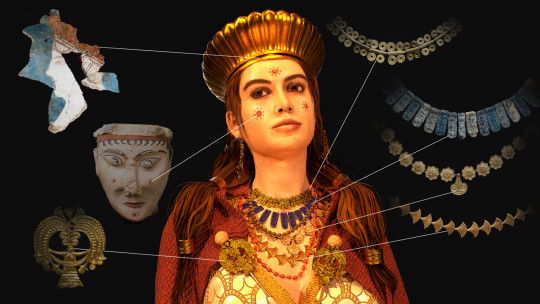

and the use of the woman head depiction for the makeup. Headbands crowns or impressive plummed hats were also a thing
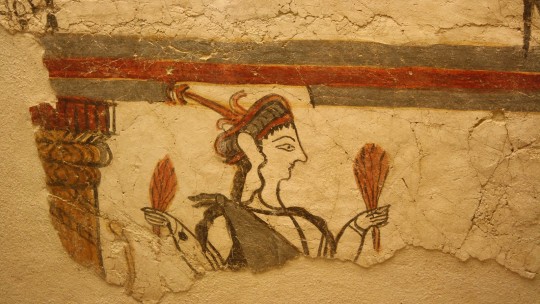
Men are quite similar and at the beginning they do resemble the minoan style but now there seems to be a turn towards hunting and war scene iconographically

where we see a variety of shields and weapons such as spears or bows also depictions of soldiers with armory:

which of course also has different shapes and materials from possibly leather ones such as these in the vase painting till full on bronze ones like this famous sample:
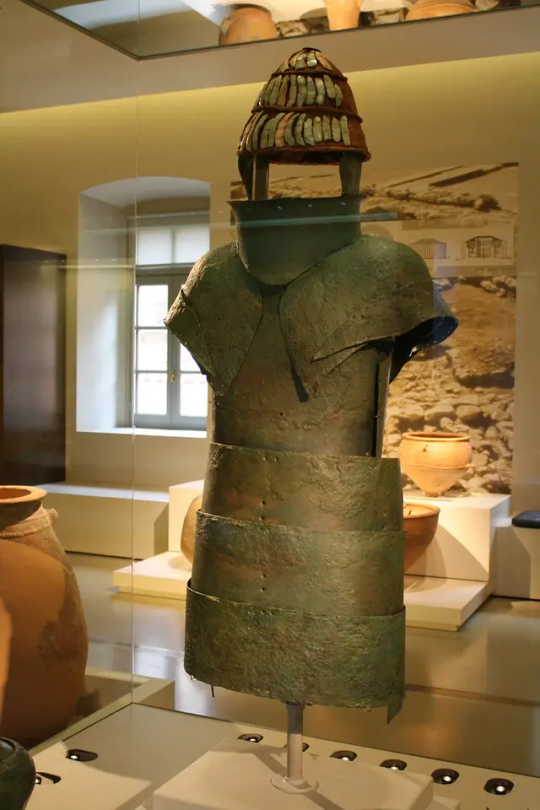
And of course the infamous boar-tusk helmet, like the one thoroughly described in the Iliad being the helmet upon the head of Odysseus:
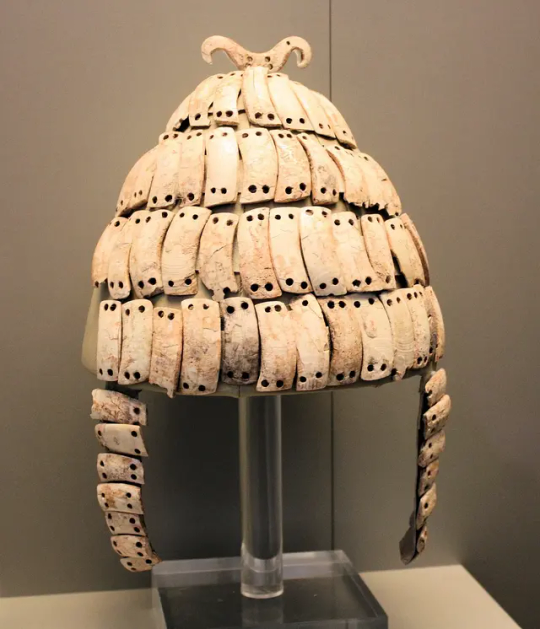
In fact Homer seems to be rather accurate on the description of it and it corresponds to the images of the vase painting with men wearing boar tusk helmets adorned with plumes and horns (yeah sweet irony how it was uncommon for Vikings to wear horned helmets and yet media depicts them with them while ancient Greeks did have horned helmets and no one depicted them with them! Hahaha!).
We also see the existence of beards to men so it seems fashion calls for beards in older men and shaven faces for younger ones which remains kinda the norm for the later years to come. Other depictions show men clothed in short nd short-sleeved chiton with or without helmets and often their clothing have vibrant colors:

Boar tusks began being kind of like a status symbol for we find many of them to burials along with weapons so we tend to believe they were signs for warriors.
For material now it seems that Homer was rather accurate depicting his women weaving and looming. The existence of loom weight in our discoveries show the woolen threads being famously used in looming and we even discovered funeral shrouds (like the one Penelope ellegedly wanted to prepare for Laertes) in burials in burial circle B in Mycenae
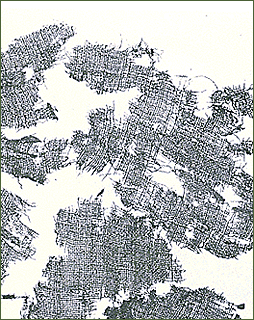
patterns were often painted or loomed upon the skirts or clothing. Flax was also another material one would expect was used at that time for clothing-making. One can assume fur or other materials from hunted or farmed animals would be used for warmth at colder months especially in cities located inside the mainland.
Thankfully for us the mycenaean greek scripture (Linear B) is deciphered so we do know on products moving from and to the palace (unfortunately the scriptures we have are mainly logistics)
So to do a recap yeah minoan and mycenaean clothing had really vibrant colors and intriquate patterns. By n large Mycenaean Civilization has simpler lines to the clpothing and tend to choose options with less nudity unless we speak on ceremonial or official dresses of the upper class (of course exceptions to the rule should have existed but we do not have as much data on it). On materials we see more wool or flax that is woven in a very skillful fashion as for armory and helmets we do see a variety of shapes and material with prominient things being leather, bronze and boar tusk.
Beautiful jewelry of gold and precious stones were also worn especially in the images of women in procession (most likely for celebrations or ceremonies). We do see depictions of men with beards and often shorter hair (possibly youths that have come of age who are to let their hair grow again, if they follow the same logic as we know of future times to follow)
Hair and hair fashion does seem to change although we discover some remains of it to the later 7th century Kouroi and Kores statues where Kouroi have often long hair depicted n ringles or ropes which again could be the indication of curly, braided or locked hair to indicate the continuation of the long-haired fashion even in later years in antiquity such as the archaic period.


Now as I said before doric greek clothing highly depends on the area, the timeline and the city-state we are talking about so it could be a subject on another ask or a reblog on specific eras and areas (Sparta Macedonia etc) depending also on the era we are talking about we can detect some differences in fashion. Generally we have more scarce information on the period of the Dark Ages (after 1100s till the 7th century BC)
For Minoans and Mycenaeans I could look for more bibliography if you want. You can check these two sites where you can find much of the information I list here:
I hope this helps a bit! I will be open for more answers in more detail! ^^
#katerinaaqu answers#greek mythology#tagamemnon#archeology#mycenaeans#minoans#minoan and mycenaean fashion#ancient greek clothing#ancient greek art#ancient greek armors#ancient greek pottery#ancient greek murals#ancient greek jewelry#history#bronze age greece#ceramic art#wallpaintings#visual art#art history
46 notes
·
View notes
Text

glass beads, c. Late Bronze Age (approximately 3200 years ago), found at Kongehøj, Denmark
Currently in the collection of the National Museum of Denmark
820 notes
·
View notes
Text



Bronze Headdress and Human Skull from Southern Austria dated between 2200-1600 BCE on display at the Natural History Museum in Vienna, Austria
This skull was found in the Traisental region to the largest Early Bronze Age burial site in Europe. Its green colour comes from a unique bronze headdress so far only found in the graves of wealthy women in Traisental. The bronze grave gifts are an indication of different social statuses within the Bronze Age communities.
Photographs taken by myself 2022
#art#fashion#bronze age#archaeology#history#austria#austrian#ancient#jewelry#jewellery#natural history museum#vienna#barbucomedie
386 notes
·
View notes
Text

Unknown Bronze Age Artisan working at site of Troy, Large Gold Diadem with Idol Shaped Pendants, ca. 2600-2300 BCE (excavated by Heinrich Schliemann, 1873), gold (Pushkin Museum of Fine Arts, Moscow [removed from Pergamon Museum, Berlin, during World War II])
Sophia Schliemann dressed by her husband as "Helen of Troy" in finds from "Priam's Treasures, " ca. 1874


20 notes
·
View notes
Text
Hällristningar / Petroglyphs
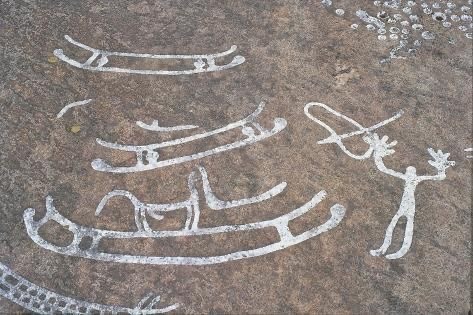
Petroglyphs have been made all around the world and in different eras. The word literally means “stone carving”.
Nordic petroglyphs are usually from the Bronze Age and are also called Hällristningar.
Some see part of the engravings as early runic symbols, but this theory is /can not be proven. Various meanings have been attested, such as territorial markings, recording (historical) events or tales, or possibly part of religious experience.
Many Nordic carvings have been painted for visibility reasons. None of these have been proven to be colored in at the time they were made.
Hällristningar are not part of the Viking age, but are often included into the Viking age by popculture. Examples of this are combining styles, decorations and time periods into tattoos or fake facts online.
Image: Tanum Petroglyphs
Found in: Litsleby, Västra Götaland - Sweden
#frankish#merovingian#viking archaeology#archaeology#carolingian#charlemagne#field archaeology#viking mythology#merovingian archaeology#germanic mythology#norse mythology#anglo saxon#viking#field archaeologist#frisian#odin#vikings#germanic#germanic folklore#germanic archaeology#wodan#anglo saxon archaeology#history#jewelry#norse#nordic bronze age#Bronze Age
34 notes
·
View notes
Text

European Bronze Spiral Armlet, 1300 B.C.
The pure geometric motif is combined in this piece with high precision of modeling. The direct use of such work is not known; it was described as wrist-guard or arm-guard. This arm-guard was designed for the left arm and, most probably, made a pair with the right one. Executed by repeated hammering with annealing, the thick bronze wire is square in cross-section. The concentric spiral forms two perfectly discoid shapes; it is thought that the spirals served to deflect the blow of a sword. The spiral finials of fibulae or wire-spirals as bracelets, made of bronze or gold, wire were popular designs in the jewelry of the European Bronze age. This arm-guard employs the same design on a monumental scale; the piece is considerably heavy but the spiral preserves a complete flexibility.
A more reasonable hypothesis would be that such objects had a ceremonial and decorative purpose, as “parade weapons”, or that they were used exclusively in the funerary sphere. At a time when bronze was still rather rare and hard to work, owning a piece such as this one, with its massive weight and size, would have elevated the social status of its owner: only the noblemen, or the princes, would have been able to commission such extraordinary armbands.
Bronze, L: 32 cm (12.6 in).
Courtesy: Phoenix Ancient Art
#art#design#fashion#women's fashion#luxury lifestyle#antique#bronze#bronze age#jewellery#jewelry#bracelet#armlet#europeen#geometric#arm-guard#history#style
15 notes
·
View notes
Text

3,600-Year-Old Jewelry and Weapon Hoard Found Under Field in Czech Republic
Archaeologists used metal detectors to find the hoard, which includes several pieces of jewelry and weapons.
Archaeologists discovered a hoard of Bronze Age artifacts while doing routine survey work in a field in the Czech Republic.
The bronze objects — which include eight arm rings, two pins, eight axes and one spearhead — were found near Budyně nad Ohří, a town about 35 miles (56 kilometers) northwest of Prague, Radio Prague International reported.
Researchers estimate that most of the items, which they found using metal detectors, date to around 1600 B.C.
"Most items are characteristic of the Middle Bronze Age, with only one ax belonging to the earlier period," Martin Trefný, an associate professor at the Museum of the Říp Region and the University of Jan Evangelista Purkyně and the curator of the hoard, said in an email. One ax is even older and dates to the Early Bronze Age.
"Axes could have been used as tools or weapons. The latter function also applies to the spearhead," Trefný said. "Bracelets were forearm ornaments, and pins served either to fasten clothing or, for example, to style women's hair."
Archaeologists remain unclear about why the hoard was buried, but they have proposed three possibilities.
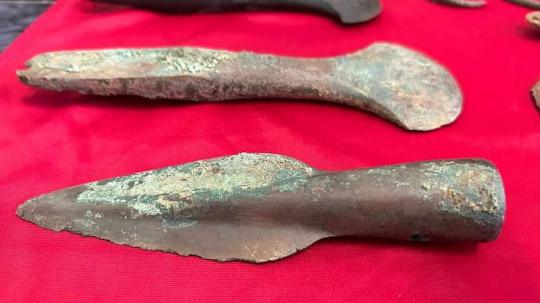
"In the first case, the hoards are presumed to have a votive function, meaning they served as offerings to deities," Trefný said. "In the second case, we speak of an economic function, where hoards are interpreted as, for example, storage for manufacturers of the given items."
Alternatively, the buried items could reflect "a crisis situation, where it was necessary to hide the items, for example, from enemies," he said.
The treasure could be worth "millions of crowns," Trefný told Radio Prague International. (One million Czech crowns, or koruna, is about $42,500.)
"All the items testify to the technological advancement of bronze casters and processors in Central Europe 3,500 years ago," Trefný told Live Science. "The composition of the hoard also contributes to understanding the warfare, craft techniques and contemporary fashion of the time. Considering that hoards might have a ritual significance, they can also reveal a bit about the contemporary religion."
In the "near future," these found items will be on display at the Podřipské Museum, located about 30 miles (50 km) north of Prague, Radio Prague International reported.
By Jennifer Nalewicki.

#3600-Year-Old Jewelry and Weapon Hoard Found Under Field in Czech Republic#Budyně nad Ohří#metal detector#metal detecting finds#bronze#ancient artifacts#archeology#archeolgst#history#history news#ancient history#ancient culture#ancient civilizations#bronze age
113 notes
·
View notes
Text

All hail the small scarab and Khepri, for all the hard work they do to move the sun and staying in fashion!𓆣
#history#scarab beetle#khepri#amulet#sun#ancient egyptian history#mythology#jewelry#egyptology#art#bronze age#ancient history#ra#insects#kemetic#ancient egypt#jewelry history#egyptian art#divine#mediterranean#coquette#egyptian mythology#art history#charms#nickys facts
7 notes
·
View notes
Text

The Mold gold cape, Wales, 1900-1600 BC
from The British Museum
254 notes
·
View notes
Note
arms?

The stunning and famous Dunavecse armlet, a Middle Bronze Age beauty. Can be found in the National Museum in Budapest, Hungary.
#dragon age#Mourn Watch#Grave Gold#Nevarra#jewelry#artifacts#Bronze Age#Carpathian#Oh no someone makes a bronze replica and I want it
6 notes
·
View notes
Text
Ancient costume jewellery. Very nice.
7 notes
·
View notes
Text

Armlet from Croatia dated between 1000-800 BCE on display at the Natural History Museum in Vienna, Austria
Photographs taken by myself 2022
#art#archaeology#history#fashion#croatia#croatian#ancient#bronze age#jewelry#jewellery#natural history museum#vienna#barbucomedie
137 notes
·
View notes